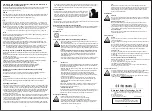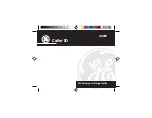
Compliance with RF Exposure Standards (If appropriate, Reference to
the actual product’s Safety Marking)
Your Retevis walkie talkie is designed and tested to comply with a number of national and
International standards and guidelines (listed below) for human exposure to radio
frequency electro-magnetic energy.
FCC ID
The
FCCID means: This radio complies with the IEEE
(FCC) and ICNIRP exposure limits
for occupational/controlled RF exposure environments at operating duty factors of up to
50% talk-50% listen and is approved for occupational use only.
The
CE marking means: Hereby, Shenzhen Retevis
Technology Co., Ltd. declares that
the radio equipment type RT30 is in compliance with the RED Directive 2014/53/EU and
the ROHS Directive 2011/65/EU and the WEEE Directive 2012/19/EU. The full text of the
EU declaration of conformity is available at
the following internet address: www.retevis.com
NOTE: The approved batteries, supplied with this
radio, are rated for a 5-5-90 duty factor
(5% talk-5% listen-90% standby) even though this radio complies with FCC
occupational exposure limits and may operate at duty factors of up to 50% talk.
IC ID
This device complies with Industry Canada license-exempt RSS standard(s). Operation is
subject
to the following two
conditions:
(1) This device may not cause interference, and
(2) This device must accept any interference, including interference that may cause
undesired operation of the device.
In terms of measuring RF energy for compliance with these exposure guidelines, your
radio generates measurable RF energy only while it is transmitting (during talking), not
when it is receiving (listening) or in standby mode.
Note:
The approved batteries, supplied with this radio, are rated for a 5-5-90 duty factor
(5% talk-5% listen-90% standby) even though this radio complies with FCC
occupational exposure limits and may operate at duty factors of up to 50% talk.
RF energy exposure standards and guidelines (if appropriate)
Your Retevis walkie talkie complies with the following RF energy exposure standards and
guidelines:
•
United States Federal Communications Commission (FCC), Code of Federal Regulations;
47 CFR part 2 sub-part J.
•
American National Standards Institute (ANSI) / Institute of Electrical & Electronic
Engineers (IEEE) C95. 1-2005
• IEEE Std. 1528:2013 and KDB447498, Evaluating
Compliance with FCC Guidelines for
Human Exposure to Radio Frequency Electromagnetic Fields.
•
Institute of Electrical and Electronic Engineers (IEEE) C95.3-2002
•
International Commission on Non-Ionizing Radiation Protection (ICNIRP)
•
Ministry of Health (Canada) Safety Code 6 & Industry Canada RSS-102.
• International Electrotechnical Com-mission IEC62209-2:201
0]
RF Exposure Compliance and Control Guidelines and Operating
Instructions
To control your exposure and ensure compliance with the occupational / controlled
environment exposure limits, always adhere to the following procedures.
Guidelines:
•
User awareness instructions should accompany the device when transferred to other
users.
•
Do not use this device if the operational requirements described herein are not met.
Operating Instructions:
•
Transmit no more than the rated duty factor of 50% of the time. To Transmit (Talk), push
the Push To Talk (PTT) button. To receive calls (listen), release the PTT button. Transmi-
tting 50% of the time, or less, is important because the radio generates measurable RF
energy exposure only when transmitting in terms of measuring for standards compliance.
•
Transmit only when people outside the vehicle are at least the recommended minimum
lateral distance away from a properly installed according to installation instructions,
externally mounted antenna.
•
When operating in front of the face, worn on the body, always place the radio in a Retevis
approved clip, holder, holster, case, or body harness for this product. Using approved
body-worn accessories is important because the use of Non-Retevis approved accessor-
ies may result in exposure levels, which exceed the IEEE/ICNIRP occupational/controlled
environment RF exposure limits.
•
If you are not using a body worn accessory and are not using the radio in the intended
use position, in front of the face or at the body in the PTT mode or alongside of the head
in the phone mode, then ensure the antenna and the radio are kept 2.5 cm (one inch)
from the body when transmitting. Keeping the radio at a proper distance is important
because RF exposures decrease with increasing distance from the antenna.
Hand-held Mode
•
Hold the radio in a vertical position with the microphone (and other
parts of the radio including the antenna) atleast 2.5 cm (one inch)
away from the nose or lips. The antenna should be kept away from
the eyes. Keeping the radio at a proper distance is important as RF
exposure decreases with increasing distance from the antenna.
Phone Mode
•
When placing or receiving a phone call, hold your radio product as you would a wireless
telephone. Speak directly into the microphone.
Electromagnetic Interference/Compatibility
Note:
Nearly every electronic device is susceptible to electromagnetic interference (EMI)
if inadequately shielded, designed, or otherwise configured for electromagnetic
compatibility.
Avoid Burns
Small Parts. Not for children under 3 years.
Turn off your radio power in the following conditions:
•
Turn off your radio before removing (installing) a battery or accessory or
when charging battery.
•
Turn off your radio when you are in a potentially
hazardous environments:
Near electrical blasting caps, in a blasting area, in explosive atmospheres
(inflammable gas, dust particles, metallic powders, grain powders, etc.).
•
Turn off your radio while taking on fuel or while parked at gasoline service
stations.
To avoid electromagnetic interference and/or compatibility conflicts
•
Turn off your radio in any facility where posted notices instruct you to do
so, hospitals or health care facilities (Pacemakers, Hearing Aids and
Other Medical Devices) may be using equipment that is sensitive to
external RF energy.
•
Turn off your radio when on board an aircraft. Any use of a radio must be
in accordance with applicable regulations per airline crew instructions.
Note:
- Pacemakers
Defibrillators or other Implanted Medical Devices Persons with pacemakers,
Implantable Cardioverter-Defibrillators (ICDs) or other active implantable
medical devices
(AIMD) should:
• ALWAYS keep the radio more than 15cm
from their pacemaker when the
radio is turned on.
•
Consult with their physicians regarding the potential risk of interference
from radio frequency transmitters, such as portable radios (poorly
shielded medical devices may be more susceptible to interference).
•
Turn the radio OFF immediately if they have any reason to suspect that
interference is taking place.
•
Do not carry the radio in a chest pocket or near the implantation site,
and carry or use the radio on the opposite side of their body from the
implantable device to minimize the potential for interference.
- Hearing Aids
Some digital wireless radios may interfere with some hearing aids. In the
event of such interference, you may want to consult your hearing aid
manufacturer to discuss alternatives.
- Other Medical Devices
If you use any other personal medical device, consult the manufacturer of
your device to determine if it is adequately shielded from RF energy. Your
physician may be able to assist you in obtaining this information.
Protect your hearing:
•
Use the lowest volume necessary to do
your job.
•
Turn up the volume only if you are in noisy surroundings.
•
Turn down the volume before adding headset or earpiece.
•
Limit the amount of time you use headsets or earpieces at high volume.
•
When using the radio without a headset or earpiece, do not place the
radio's speaker directly against your ear.
Note:
Exposure to loud noises from any source for extended periods of time
may temporarily or permanently affect your hearing. The louder the radio's
volume, the less time is required before your hearing could be affected.
Hearing damage from loud noise is sometimes undetectable at first and
can have a cumulative effect.
Avoid Burns
Antennas
• D
o not use any portable radio that has a damaged antenna. If a damaged
antenna comes into contact with the skin when the radio is in use, a minor
burn can result.
Batteries (If appropriate)
• Wh
e
n the conductive material such as jewelry, keys or chains touch
exposed terminals of the batteries, may complete an electrical circuit
(short circuit the battery) and become hot to cause bodily injury such as
burns. Exercise care in handling any battery, particularly when placing it
inside a pocket, purse or other container with metal obj
ects.
Long transmission
• Wh
en the transceiver is used for long transmissions, the radiator and
chassis will become hot.
Safety Operation
- Forbid
•
Do not use charger outdoors or in moist environments, use only in dry
locations/conditions.
•
Do not disassemble the charger, that may result in risk of electrical shock
or fire.
•
Do not operate the charger if it has been broken or damaged in any way.
•
Do not place a portable radio in the area over an air bag or in the air bag
deployment area. The radio may be propelled with great force and cause
serious injury to occupants
of the vehicle when the air bag inflates.
- To reduce risk
•
Pull by the plug rather than the cord when disconnecting the charger.
•
Unplug the charger from the AC outlet before attempting any maintenance
or cleaning.
•
Contact Retevis for assistance regarding repairs and service.
- Use of Communication Devices While Driving
•
Always check the laws and regulations on the use of radios in the countries
and areas where you drive.
•
Give your full attention to driving and to the road.
• If available, use the hands-free facility.
•
If driving conditions or regulations require it, pull off the road and park
before making or answering a call.
Approved Accessories
•
This radio meets the RF exposure guidelines when used with the Retevis
accessories supplied or designated for the product. Use of other
accessories may not ensure compliance with the RF exposure guidelines
and may violate regulations.
•
For a list of Retevis-approved accessories for your radio model, visit the
following
website: http://www.Retevis.com
WARNING
WARNING
WARNING
WARNING
WARNING
EU Importer
:
Name
:
Germany Retevis Technology GmbH
Address
:
Uetzenacker 29,38176 wendeburg
4
5
6
--------------------------------------------------
Shenzhen Retevis Technology Co.,Ltd
Add
: 7/F, 13-C, Zhonghaixin Science&Technology Park, No.12
Ganli 6th Road, Jihua Street, Longgang District, Shenzhen,
China
Web:www.retevis.com
E-mail:[email protected]
Facebook:facebook.com/retevis
MADE IN CHINA












